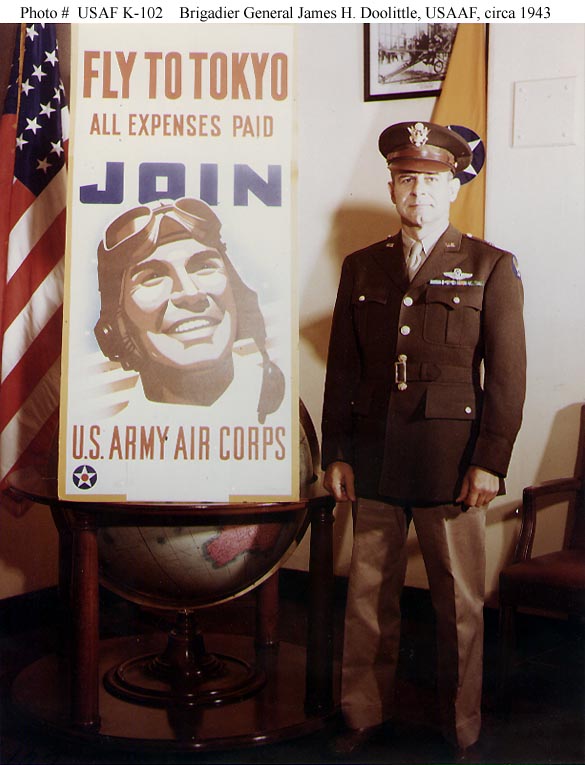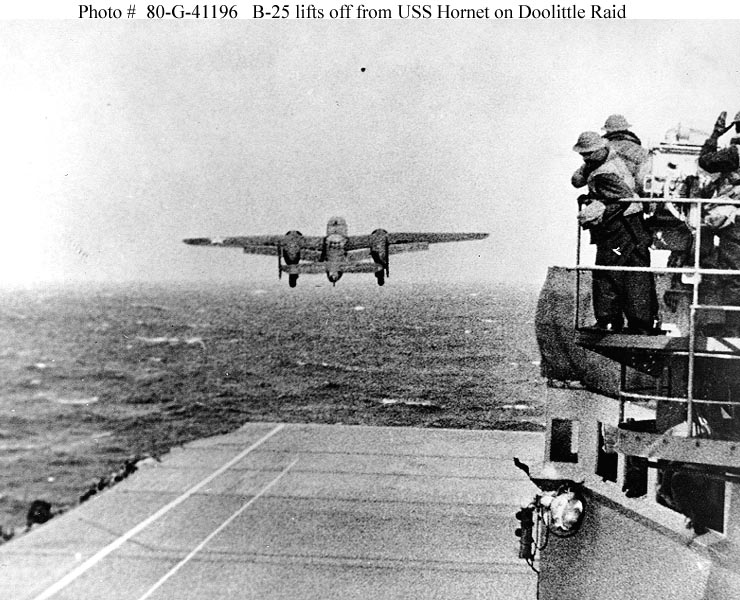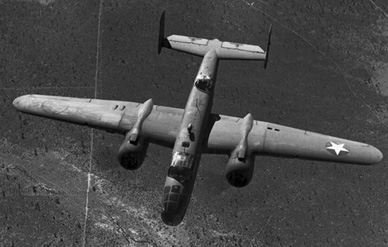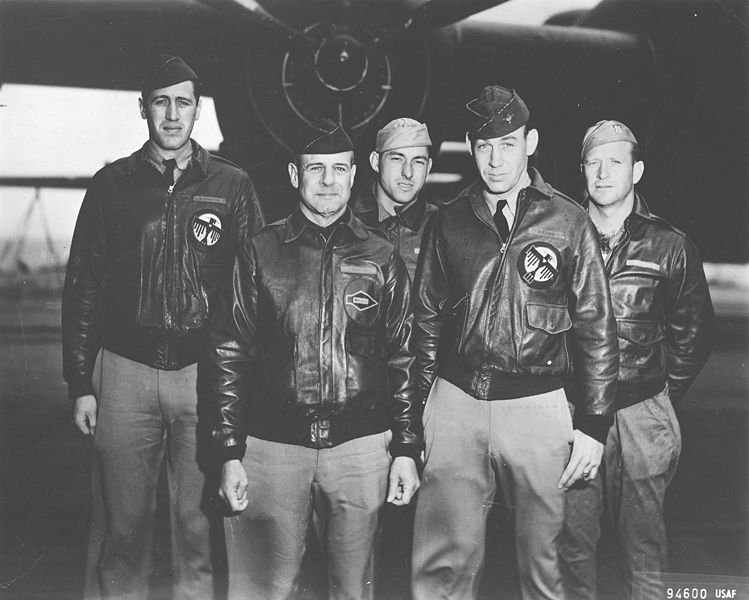Why were B-25s at Lake Murray? (Columbia's relationship with the Doolittle Raiders)
 The Story of B-25s at Lake Murray started with Japan's attack on Pearl Harbor on December 7, 1941 in World War II. After declaring war against Japan, the United States military began planning a top-secret air raid mission against Japan. The raid was planned and led by Lieutenant Colonel James "Jimmy" Doolittle. Doolittle would later recount in his autobiography that the raid was intended to cause the Japanese to doubt their leadership and to raise American morale. The Doolittle Raid, on April 18, 1942, was the first air raid by the United States to strike a Japanese home island during World War II. Doolittle was a famous civilian aviator and aeronautical engineer before the war.
The Story of B-25s at Lake Murray started with Japan's attack on Pearl Harbor on December 7, 1941 in World War II. After declaring war against Japan, the United States military began planning a top-secret air raid mission against Japan. The raid was planned and led by Lieutenant Colonel James "Jimmy" Doolittle. Doolittle would later recount in his autobiography that the raid was intended to cause the Japanese to doubt their leadership and to raise American morale. The Doolittle Raid, on April 18, 1942, was the first air raid by the United States to strike a Japanese home island during World War II. Doolittle was a famous civilian aviator and aeronautical engineer before the war.
The 17th Bomb Group was chosen to provide the pool of crews from which volunteers would be recruited. At this point and throughout the training, the mission was still secret and the volunteers did not know their final mission. The 17th BG, then flying antisubmarine patrols from Pendleton, Oregon, was immediately moved cross-country to Lexington County Army Air Base near Columbia, South Carolina. This is the present day Columbia Metropolitan Airport.
The group officially transferred to Columbia effective February 9, 1942, where its combat crews were offered the opportunity to volunteer for an "extremely hazardous" but unspecified mission. The group had a short stay in Columbia to organize and train. After the Columbia training, other training was done in Florida.
 On April 1, 1942, the bombers and the "Doolittle Raiders" were loaded on the USS Hornet for the sailing towards Japan. Sixteen B-25B Mitchell bombers were launched from the aircraft carrier USS Hornet deep within enemy waters. The plan called for them to hit military targets in Japan, and land in China although one B-25 landed in Soviet territory and the crew was interned in the Soviet Union for more than a year. All 16 aircraft were lost and 11 crewmen were either killed or captured. The crews of 14 aircraft, in their entirety returned safely to the United States or to Allied control.
On April 1, 1942, the bombers and the "Doolittle Raiders" were loaded on the USS Hornet for the sailing towards Japan. Sixteen B-25B Mitchell bombers were launched from the aircraft carrier USS Hornet deep within enemy waters. The plan called for them to hit military targets in Japan, and land in China although one B-25 landed in Soviet territory and the crew was interned in the Soviet Union for more than a year. All 16 aircraft were lost and 11 crewmen were either killed or captured. The crews of 14 aircraft, in their entirety returned safely to the United States or to Allied control.
The Doolittle raid did little material damage to Japan. However, when news of the raid was released, American morale soared. The raid did have an important strategic impact, though it was not understood at the time, in that it caused the Japanese to recall some fighter units back to the home islands for defense.
Doolittle was awarded the Medal of Honor by President Roosevelt, and was promoted two grades to Brigadier General, skipping the rank of colonel. He went on to command the Twelfth Air Force in North Africa, the Fifteenth Air Force in the Mediterranean, and the Eighth Air Force in England during the next three years. All 80 Raiders received the Distinguished Flying Cross and those who were killed, wounded or injured as a result of the raid also received the Purple Heart. In addition, every Doolittle Raider received a decoration from the Chinese government.
The Doolittle Raiders have held an annual reunion almost every year since the late 1940s. Several of these reunions have been in Columbia, South Carolina (including 2009). As of 2009, only nine Raiders are still alive.
 Lake Murray's B-25
Lake Murray's B-25
While the Doolittle Raiders group went off to California for the mission to Japan, other pilots continued to train at Lexington County Army Air Base. Many flights were conducted over Lake Murray for practice bombing runs. Records indicate that at least five B-25s crashed into the lake, three were immediately salvaged, and at least one remained abandoned at the bottom of Lake Murray.
On April 4, 1943, a B-25 took off from the Army Air Base outside Columbia on a skip-bombing mission over the lake’s island targets. The crew ditched in the water about two miles west of Dreher Shoals Dam when the left engine lost power. It finally ended up at the bottom of Lake Murray, at a depth of 150 feet—too deep for the U.S. Army Air Forces to salvage it. It was written off as a loss.
Greenville resident Dr. Bob Seigler had researched the plane since 1989. In 1992, he was working with the US Naval Reserve Sonar Unit when they located the exact position. With help from attorney John Hodge, they began the long process of obtaining salvage rights from South Carolina Electric and Gas, the owner of Lake Murray, as well as securing a quit-claim deed from the United Sates Air Force. Also, a host museum had to be found. Dr. Seigler, John Hodge and Dr. Bill Vartorella, formed the Lake Murray B-25 Rescue Project to salvage the aircraft from the bottom of Lake Murray.
In September 2005, the plane was brought to the surface by a team of divers, aviation historians, and explorers. The aircraft was transported to the Southern Museum of Flight in Birmingham, Alabama, for stabilization and permanent exhibition. John Hodge, Dr. Bob Seigler, and Dr. Bill Vartorella were honored by receiving the Order of the Palmetto, South Carolina's most prestigious civilian award on May 21st, 2008 at the opening of an exhibit at the South Carolina State Museum.
Heard of or seen the purple martin's nesting site at Lake Murray? It's a very popular viewing site for Lake Murray boaters during the summer months. That's Doolittle Island (also called Lunch Island or Bomb Island). This was the bombing range site for many B-25 practice bombing missions at Lake Murray.

Southern Museum of Flight | Lake Murray's Mitchell - AirSpaceMag.com | Catch of the Day - B-25 Bomber Exhibit
For the complete story on the Doolittle Raid and the Doolittle Raiders, click on the links below:
Jimmy Doolittle and the Tokyo Raiders Strike Japan During World War II | Doolittle Raid - Wikipedia | The Doolittle Raid with Animated Graphics | The Doolittle Raid Remembered | How S.C. Helped Win World War II | Official Website of The Doolittle Tokyo Raiders

Lake Murray * Lake Murray SC * Lake Murray South Carolina
Lake Murray B-25 * Salvage B-25 from Lake Murray * B-25 Recovery at Lake Murray * B-25 at Lake Murray * Lake Murray B-25 pictures